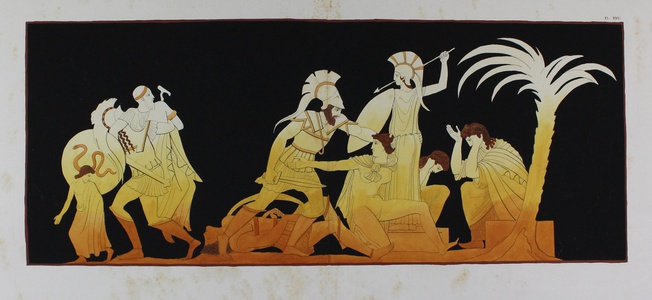| Method | Copper engraving with hand colouring |
| Artist | Antoine Clener |
| Published | A Paris de l'Imprimerie de P. Didot l'Aine MDCCCVIII [1808] |
| Dimensions | Image 244 x 610 mm, Plate 280 x 632 mm |
| Notes |
An impressive double-sheet depiction of a red-figure vase decoration of events from the Fall of Troy, Plate 25 from Volume 1 of Peintures de vases antiques, vulgairement appelés étrusques. The scene shows the flight of the Trojan hero, Phrygian prince, and ancestor of the Roman people, Aeneas, from the ruins of the city of Troy. The hero can be seen at the left of the scene, still in full armour, including his high-crested and plumed helmet, cuirass, sword, and snake-emblazoned shield. He carries in his right arm his elderly father, Anchises, bearded, bald-headed, and carrying a crooked walking stick. Before him runs the young Ascanius, his son. The scene they leave behind is one of utmost devastation. A Greek in full armour storms a temple of Athena (Roman Minerva), the goddesses cult statue shown behind him. Striding over the corpse of another Trojan hero, he grasps the hair of a suppliant woman, who clings to the statue for mercy. Behind the statue, in a grove under a palm sit two women, wailing in misfortune, who are likely priestesses of the temple. Millin, in his commentary, suggests that the central figures are almost certainly the Greek hero Ajax the Lesser, and the Trojan princess and prophet Cassandra. In most versions of the story, Ajax, having found the young woman seeking sanctuary in the temple, raped her, thus invoking the wrath of the goddess Athena, whose shrine and devotee he had violated. The dead Trojan youth is most likely Coroebus, the son of King Mygdon of Phrygia, who was killed by Diomedes and Neoptolemus while attempting to protect the unfortunate Cassandra. Peintures de vases antiques, vulgairement appelés étrusques was an early nineteenth century French answer to the hugely popular and influential series of engravings and descriptions of Greek vases assembled by Sir William Hamilton, the British envoy to the Kingdom of Naples and Sicily. Following the withdrawal of the British from Bourbon Naples, in the face of Napoleon and the revolutionary army, the excavations of archaeological sites in the region yielded numerous examples of Greek red-figure vases for French museums, galleries, and private collectors. Authored by Aubin-Louis Millin de Grandmaison, the leading French authority on Greek vases, and featuring illustrations by Antoine Clener, the two-volume publication featured examples of Greek vase painting from the Malmaison, the Musee Napoleon, the Bibliotheques imperial and nationale, and numerous private French collections. In style, it closely resembled the two different editions illustrating Hamilton's vases. The artist Clener had even been the pupil of Hamilton's artist Tischbein during the preparation of plates for his second publication. Akin to this second Hamilton collection, the plates in the Peintures de vases antiques were left uncoloured at publication, ostensibly for the benefit of artists and academics wishing to study the fine details of line and composition, though the publication contained a similar note to connoisseurs that with the assistance of a skilled colourist, the full impact of these masterworks of classical art could be appreciated by the discerning collector. Antoine Clener (fl.1790-1810) was a French engraver, principally known for his plates of Greek vases. As a young man, he worked as a pupil of Johann Heinrich Wilhelm Tischbein, and it was likely through his master's work on the Hamilton vases that gained him his most notable commission producing copper engraved plates for Millin de Grandmaison's Peintures de vases antiques, vulgairement appelés étrusques. Aubin-Louis Millin de Grandmaison (19th July 1759 – 14th August 1818) was a French author, antiquarian, connoisseur, and natural historian. Having fallen foul of the Jacobins and removed from his editorship of the Chronique de Paris, he was later appointed the chair of archaeology at the Bibliotheque nationale, expanding the institute's holdings of classical and medieval art, and becoming, in the last decades of his life, a specialist on the subject of classical vase painting. In addition to his antiquarian work, he was also a prominent member of the naturalist community, founding the world's first Linnean Society. Condition: Central vertical fold as issued. Foxing and time-toning to margins and central fold. Otherwise a strong impression in superb heavy colour. |
| Framing | unmounted |
| Price | £500.00 |
| Stock ID | 43483 |

